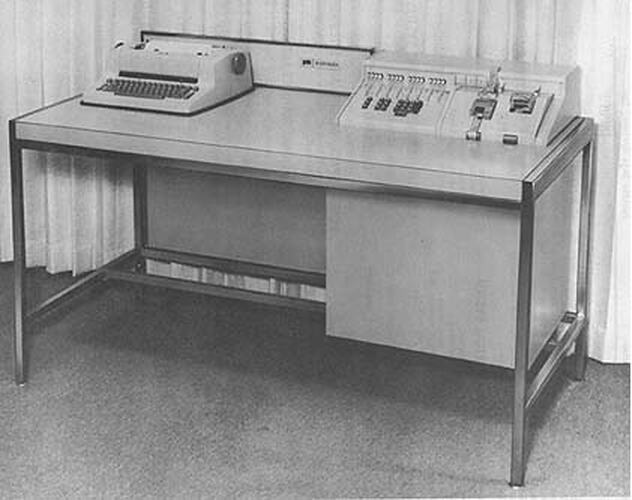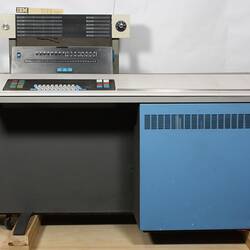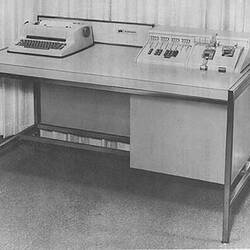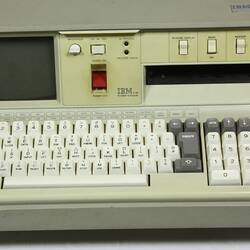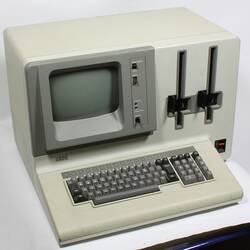Summary
PDS 1020 computer made by Pacific Data Systems in 1964.
The machine's first owner was a New South Wales engineering firm; it was only one of two imported from the United States into Australia. It was expensive, in the five figure range. The firm employed it for engineering calculations, such as construction and soil testing. The second owner was a software developer, Burra Computer Services. The donor was employed by the company, which bought it after it was advertised in a trade publication. They hoped to use it as a word processor and printer. Although it worked well as a printer, there were too many software problems, for example with proportional spacing in documents. The project was abandoned.
The machine was a commercial desktop computer that could be used in ordinary office situations at a time when most computers were mainframe that required special environmental conditions. It used paper tape for data and program input and had a delay line memory of the magnorestrictive type. It took about half an hour to warm up. It was built completely with solid-state circuitry.
The PDS 1020 was described by the manufacturer as an engineering digital computer that combined slide-rule convenience and calculator simplicity with the versatility and capacity of the modern general purpose digital computer. It could be used to solve a broad spectrum of engineering problems.
Programs could be stored internally or externally on paper tape.
Programming used 6 keyboard commands, 31 machine commands, and 10 macro-commands.
The manufacturer promoted the following features:
- A versatile computer designed to be used directly by engineers.
- Keyboard operation for rapid problem solving.
- Internal program storage for solving more complex problems.
- The computer features a self-contained engineering oriented keyboard which allowed the user to easily solve problems ranging from simple questions to more complex iterative problems.
- Standard functions including square root, COS, SIN, LOG, etc., could be automatically executed from the keyboard, as well as ADD, SUB, MULTIPLY and DIVIDE.
- Other operator generated sequences could be internally stored and executed by pushing a single key.
- Parity checking.
List of Parts:
SPECIFICATIONS:
Arithmetic Unit: Incl. Stor. Access
Add 11,500 microsec
Mult 40,000 microsec
Div 40,000 microsec
Arithmetic mode: Serial
STORAGE:
Magnetostrictive Delay Line: 1,024 - 4,096 words; 17 binary digits/word; access 2,300 microsecs
INPUT:
Keyboard: Manual
Paper Tape: 50 chars/sec
Four Switches (Branch): Manual
Ten Macrocommand Switches: Manual
OUTPUT:
Typewriter: 15 chars/sec
Paper Tape: 50 chars/sec
Physical Description
Desk Unit Box of paper tape One memory module separated Spare paper tape reader Spare paper tape punch Maintenance Manual
Significance
A large desktop console, this machine is an example of the transition from floor mounted computers with work stations (minicomputers, for example, the IBM System 3) to microcomputers with the standard configuration - box, screen, keyboard and, later, mouse.
The PDS 1020 employed a delay line memory. Delay line memories were used in early computers, such as CSIRAC and were an important technological development from World War II (1939 - 1945). There were different types, such as magnetostrictive (PDS 1020) and mercury delay lines (CSIRAC). The next stage was core memory.
More Information
-
Collecting Areas
-
Acquisition Information
Cultural Gifts Donation from Mr Karl Terauds, 11 Jul 2001
-
Manufacturer
Pacific Data Systems Inc, Los Molinos, California, United States of America, circa 1964
-
Past Owner or User
Burra Computer Services, Melbourne, Victoria, Australia, 1965-1975
Dates are a best guess -
Classification
-
Category
-
Discipline
-
Type of item
-
References
Computer History Museum accessed 11 January 2012: [Link 1]
-
Keywords
Computer Components, Computer Memory Devices, Computers, Computing, Delay Line Computer Memory Devices, Desktop Computers
